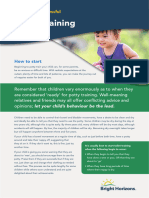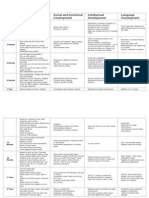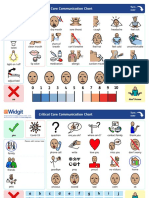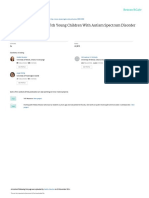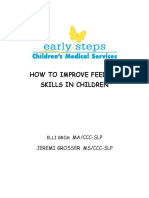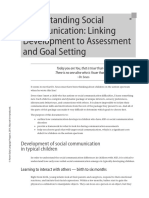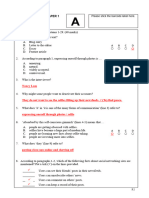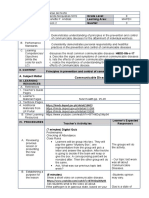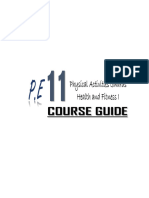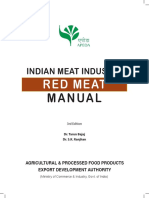Developmental Milestones – OSCE Guide
geekymedics.com/developmental-milestones/
Thom Finnerty
Children acquire functional skills throughout their childhood and we use the term
‘development’ to describe those skills acquired between birth and approximately 5 years
of age. It’s important we’re able to recognise these skills as they are useful to track a
child’s progress as they grow and to allow identification of potential developmental
problems. Early recognition is key in the management of developmental delay –
making the knowledge of these key age-related moments or ‘developmental
milestones’ all the more important.
Areas of development
Developmental milestones may be separated into four functional areas:
Gross motor
Vision and fine motor
Hearing, speech and language
Social, emotional and behavioural
Developmental milestones must be considered in regards to their ‘median age of
acquisition’ (when half of a standard population of children achieve that level) and the
‘limit age’ by which they should have been achieved. Limit ages are generally
considered to be two standard deviations from the mean age of acquisition. If the skill is
not achieved by this age, more detailed assessment, investigation or intervention may be
required. For instance, when considering the milestone of walking – the median age is 12
months, with a limit age of 18 months.
Developmental milestones are acquired in a serial manner – one after the other – and
their achievement follows a similar pattern between children. Below is a list of milestones
by median age of acquisition, sorted by functional areas.
Gross motor development
1/6
�Age Milestone
Newborn Limbs flexed, symmetrical pattern
Marked head lag on pulling up
6–8 Raises head to 45 degrees in prone (tummy-time)
weeks
6–8 Sits without support (initially with a round back, then eventually with a
months straight back by 8 months)
Limit age: 9 months
8–9 Crawling
months
10 Stands independently
months
Cruises around furniture
12 Walks unsteadily – a broad gait, with hands apart
months
Limit age: 18 months
15 Walks steadily
months
2.5 years Runs and jumps
Gross motor developmental milestones 1
Vision and fine motor development
Age Milestone
6 weeks Follows moving object or face by turning the head
(fixing and following)
Limit age: 3 months
2/6
�4 months Reaches out for toys
Limit age: 6 months
4 – 6 months Palmar grasp
7 months Transfers toys from one hand to another
Limit age: 9 months
10 months Mature pincer grip
Limit age: 12 months
16 – 18 months Makes marks with crayons
14 months – 4 years Tower of three – 18 months
Brick building Tower of six – 2 years
Tower of eight or a train with four bricks – 2.5 years
Bridge (from a model) – 3 years
Steps (after demonstration) – 4 years
2 – 5 years Pencil skills Line – 2 years
(see below):
Circle – 3 years
Drawing without seeing how
it is done. Cross – 3.5 years
Can copy 6 months earlier. Square – 4 years
Triangle – 5 years
Fine motor developmental milestones 2
3/6
� Fine motor milestones (stacking blocks and
drawing shapes)
Hearing, speech and language development
Age Milestone
Newborn Startles to loud noises
3 – 4 months Vocalises alone or when spoken to, coos and laughs “aa, aa”
7 months Turns to soft sounds out of sight
Polysyllabic babble (“babababa, lalalalala”)
7 – 10 Sounds used indiscriminately at 7 months
months
Sounds used discriminately to parents at 10 months “Dada, Mama”
12 months Two to three words other than ‘Dada’ or ‘Mama’
Understands name “Drink”
18 months 6-10 words
Is able to show two parts of the body “Where is your nose?” – Baby
will point
20 – 24 Joins two or more words to make simple phrases “Give me teddy”
months
2.5 – 3 years Talks constantly in 3 – 4-word sentences
Understands 2 joined commands “Push me fast Daddy”
Hearing, speech and language developmental
milestones 3
4/6
�Social, emotional and behavioural development
Age Milestone
6 weeks Smiles responsively
Limit age: 8 weeks
6 – 8 months Puts food in their mouth
10 – 12 months Waves bye-bye, plays peek-a-boo
12 months Drinks from a cup with two hands
18 months Holds spoon and gets food safely to mouth
18 – 24 months Symbolic play
Limit age: 2 – 2.5 years
2 years Toilet training: dry by day
Pulls off some clothing
2.5 – 3 years Parallel play
Interactive play evolving
Takes turns
Social, emotional and behavioural developmental
milestones 4
Tips for assessing development
Consider the child’s age and then using the above examples, focus your questions
on the likely areas of current developmental progress.
Offer the child suitable toys to assess skills through play.
Observe how the child uses toys and interacts with people.
5/6
�Red flags
Simplified ‘limit age’ guides have been produced for health practitioners and parents to
facilitate the early identification of developmental delay (here is an example).
References
Text references
Lissauer, T., Clayden, G., & Craft, A. (2012). Illustrated textbook of paediatrics.
Edinburgh: Mosby.
Tasker, R. C., McClure, R. J., & Acerini, C. L. (2013). Oxford handbook of
paediatrics. Oxford: Oxford University Press.
Child Development Program (2016). Red Flags Early Identification Guide. 2nd Ed.
Queensland Government. [LINK]
Images references
1. Gross motor: “Stumbling Baby” by Christopher is licensed under CC BY 2.0.
2. Vision and fine motor:
“Shaelyn” by Mike Schmid, Flickr is licensed under CC BY-SA 2.0
“Bubble Boy” by Mark Evans, Flickr is licensed under CC BY 2.0
“Baby Learns How To Grab 2” by Thomas, Flickr is licensed under CC BY 2.0
“This work” by Flickr is licensed under CC BY 2.0
3. Social, emotional and behavioural development:
“First smile” by Upsilon Andromedae, Flickr is licensed under CC BY 2.0
“plum and stuff” by Sami Keinänen, Flickr is licensed under CC BY-SA 2.0
“IMG_6591” by Abigail Batchelder, Flickr is licensed under CC BY 2.0
“Drinking Water” by Henry Burrows, Flickr is licensed under CC BY-SA 2.0
“Open wide” by Alexis Millican, Air Force Medical Service Photos is licensed
under CC BY 2.0
6/6



